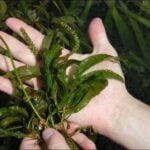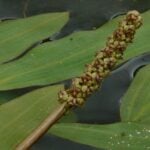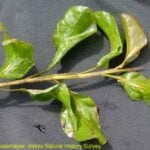Illinois Pondweed
Other Common Names:
(Potamogeton illinoensis)
Native
Illinois pondweed has lance shaped submerged leaves eight inches long that come to a point at the end.
Description
Horizontal rhizomes underground have red spots and are up to two-tenths of an inch in diameter. Illinois pondweed stems grow up to six feet tall and less than a half inch wide.
This plant has thin submersed leaves that are usually somewhat curved and elliptical or sword shaped. The leaves are eight inches long, nearly two inches wide, have a sharp tip, and are attached directly to the stem or have a short stalk.
When growing in mineral rich water, a coating of calcium or magnesium carbonate can deposit itself on the leaves, making the leaves feel crusty.
Illinois pondweed does not usually produce floating leaves. If it does, floating leaves are leathery, elliptical shaped, gradually become submersed, and are about seven inches long and two and a half inches wide. These leaves are either on a short stalk or directly attached to the stem.
The flower spikes of Illinois pondweed rise one to three inches above the water, are thicker than the stem, and have tiny green flowers whorled along the spike that is one to three inches long.
Large leaf pondweed can hybridize with Illinois pondweed.
American pondweed’s floating leaves look similar, but Illinois pondweed floating leaves are typically not present. If they are, the difference is that American pondweed leaves have long leaf stalks and Illinois pondweed has short or no leaf stalks.
As is the case with most types of pondweeds, Illinois pondweed seeds are eaten by ducks and geese; and muskrats, beavers, deer, and moose eat other parts of the plant.
Management Options
Click here for more information on how to control Illinois pondweed.
Location
Illinois pondweed can be found across the United States.
Propagation
roots, seeds
Management Options
Click here for more information on how to control Illinois pondweed.




